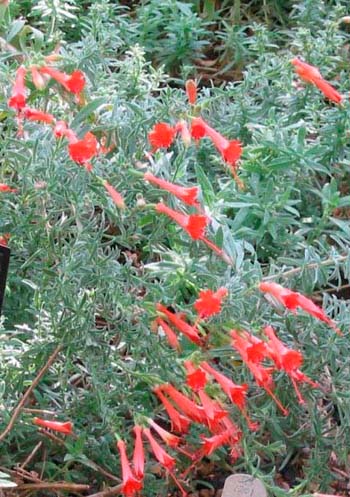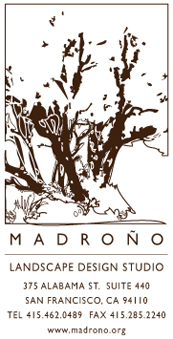 Fire danger is high on Mount Diablo in October -- perhaps because the arch-fiend haunts his namesake peak for the season of All Hallow's Eve, but more likely because the summer months have brought little water, and the parched local plant life must endure the purgatory of autumn while awaiting winter rains. Rocky, striated soil testifies to ancient forces in the bowels of the earth, and sustains today's fire-dependent ecosystem. Such infernal conditions have produced a hardy and drought-tolerant flora in a palette of feverish reds, subtle yellows, and silvery greens. Not only do the native plants of Mount Diablo "care for themselves" in the garden, but they evince an awareness of our history and help to define the identity of our region.
Fire danger is high on Mount Diablo in October -- perhaps because the arch-fiend haunts his namesake peak for the season of All Hallow's Eve, but more likely because the summer months have brought little water, and the parched local plant life must endure the purgatory of autumn while awaiting winter rains. Rocky, striated soil testifies to ancient forces in the bowels of the earth, and sustains today's fire-dependent ecosystem. Such infernal conditions have produced a hardy and drought-tolerant flora in a palette of feverish reds, subtle yellows, and silvery greens. Not only do the native plants of Mount Diablo "care for themselves" in the garden, but they evince an awareness of our history and help to define the identity of our region.
The level of vegetation diversity here reaches nearly as high as the mountain itself. Mount Diablo State Park encompasses 81,000 acres, with countless trails to explore and a litany of evocative place names that read like poetry: Prospector's Gap, Grapevine Spring, Alamo Canyon, Hidden Pond, Black Hawk Ranch, Sycamore Creek, Fossil Ridge, Knobcone Point, and many more. Rich associations between geology and biology give rise to a number of distinct plant communities -- including woodland, chaparral, grassland, and riparian -- a smorgasbord for the casual leaf-peeper and the home horticulturalist, and all within the course of a single day's hike. Insiders recommend Mitchell Canyon (on the north side of the park near Clayton) as the best destination.
Prized for an autumnal bloom attracting hummingbirds, low-growing Epilobium canum (formerly Zauschneria and still known by the common name California Fuchsia) punctuates the dry October landscape with silky bluish-green plumes covered in tubular red flowers. It clings to rocky embankments on the margins of chaparral and spreads by creeping, rarely reaching more than 1 or 2 feet tall. An excellent edging for sunny beds or along the base of walls, this perennial is indispensable in the garden for its brilliant fall color when other plants have gone to seed. Here on Mount Diablo, Epilobium canum grows together with California sagebrush, bush monkeyflower, black sage, and Yerba Santa, all outstanding choices for the California habitat garden.

